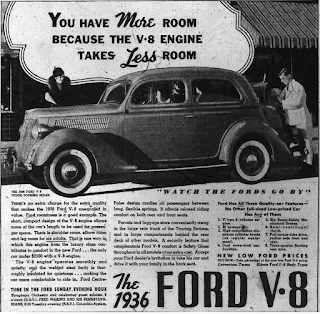Another
reason is the lack of physical space afforded under the hood of your typical
1930s Ford. The flathead V8 was a
compact motor, so it didn’t need as much space – especially fore and aft. A SBC fits very well within the confines of a
blue oval engine bay. While a small
block Ford is typically narrower than its Chevy counterpart, it has a bit of a
longer block and therefore takes up a bit more space between the radiator and
the firewall. Water pumps, radiator fans
and other accessories mounted to the motor all need to squeeze in there
too. This means there more modifications
(and more dollars) are required to fit all of the components necessary for the
engine to thrive in its new digs.
As this ad from 1936 shows, Ford was
quite proud of its compact power plant.
Due to its diminutive dimensions, their passenger cars could offer good
power and more passenger space between the wheels compared to other competitors
six and eight cylinder inline engines.
So why get
rid of the flathead in the first place?
It’s true
that the little V8 was a good performer in its time. However, with a top-of-line output of about
90ish horsepower, the flathead of the 1930s simply lacks gumption when compared
to more modern V8s. Even fully built
naturally aspirated flatheads are only good for around 200 horses. Furthermore, for the amount of money needed
get this sort of output, you could probably have more than double that out of a
SBC with enough cash leftover to buy the materials for a new bathroom
renovation. Unfortunately, while there
is little that compares to the flathead in terms of character, personality
can’t increase your trap speed.
At the end of the day though, it all depends on your goals. Sure a typical flathead will have a hard time competing with today’s most modest engines. However, they can be built at a reasonable price to have enough get up and go that you won’t be embarrassed by every Dodge Neon or Plymouth Sundance.
Also,
flatheads have an undeniable cool factor.
They are immediately distinguishable from their overhead valve cousins,
and just drip with nostalgic awesomeness.
However, if you want to go as fast as possible, you would be hard
pressed to find a better value than a modified small block Chevy... but I would
NEVER do that to an old Ford.
TTFN


No comments:
Post a Comment